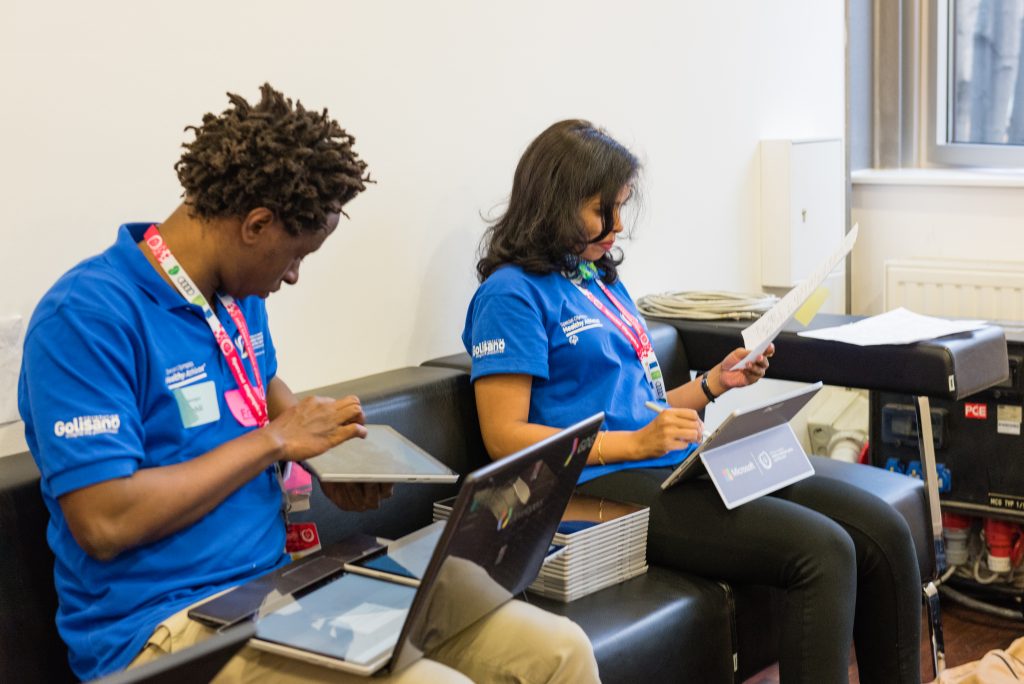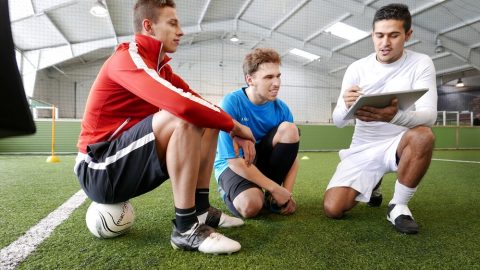About to turn 50, Special Olympics is feeling rejuvenated after a tech makeover
Special Olympics is turning 50 next year, but to long-time volunteer coach Bryan Tweit, the organization for athletes with intellectual disabilities seems almost brand-new as it rejuvenates itself with the cloud and other technological advances to provide better sports experiences.
In an interview from Austria, where the Special Olympics World Winter Games were held in March, Tweit said he employs advanced technology as a professional ski and snowboard instructor in Oregon. For example, he uses high-resolution video with apps that analyze the angles of skiers’ shoulders, hips, knees and even hands as they descend a mountain, while measuring the snow on their skis’ edges during turns, to break down the details of improvements the athletes could make.
So as Tweit has coached alpine skiing for Special Olympics the past 25 years, it has been beyond frustrating for him to be stuck in the “Dark Ages.” That’s how Special Olympics Chairman Tim Shriver, whose mother, Eunice Kennedy Shriver, founded the organization in 1968, described the non-profit’s processes last year. The group didn’t have the funds or resources to keep up with technology.

Tweit, who also runs the downhill-ski portion of Oregon’s state games for Special Olympics, said paper records and manual data-entry systems left competitions susceptible to scoring errors that meant medals were occasionally errantly withheld, or wrongly awarded and taken back.
“One of my athletes was already on his way home after a competition, thinking he hadn’t won anything even though he felt like he’d performed really well, and then they discovered they’d had him in the wrong column on the wrong sheet, and he’d actually won a gold medal,” Tweit said. “But by that point, all they could do was mail the medal to him. So he didn’t get to stand on the podium or enjoy the recognition and support from the ceremony or experience any of that excitement that’s so important.
“You know the technology exists to avoid these instances, and you just wish it could be utilized,” he said.
Tweit’s wish is coming true – and then some. Special Olympics is completely revamping its operations, providing a whole new experience for everyone involved.
One goal is to scrap paper records in favor of the cloud, to help athletes, coaches and fans get instant information, both online and on mobile devices, instead of having to wait hours or even days. That approach will help Special Olympics use data to do more for millions of people, including the 2,600 athletes, 1,100 coaches and 3,000 volunteers who participated in nine winter sports at the games in Austria.
“We have to begin to do things better, and we knew we had to take this massive leap forward,” said Mary Davis, who has worked with Special Olympics since 1978 and was appointed its chief executive officer last year. “We’ve reached 5.3 million athletes and Unified Sports partners from 169 countries, but there are 200 million people with intellectual disability in the world. We realized that one way to reach them faster and provide better quality of service is with the help of technology like the cloud.”
Lonnie Snyder, Special Olympics’ senior vice president of information technology, said the organization had a cobbled-together system of aging and unreliable computers and servers when he started about five years ago. Then Microsoft signed up as a partner in 2014, promising to modernize the group’s technology while raising funds and awareness for the Special Olympics mission of creating inclusive communities.
“We have really pole-vaulted,” Snyder said. “We still have limited resources, but now we have a reliable infrastructure and computers, and we can support a Games Management System that’s deployed for thousands of global, regional and local competitions a year.”

The new Games Management System got a trial run at the World Summer Games in Los Angeles in 2015. It’s a database that houses information on athletes, such as their performance history, medical records, contact and family information and coaches. It also runs and manages competitions, and connects timing systems.
By moving the system to Microsoft’s cloud-based Azure platform, Special Olympics managed to avoid outages in L.A. that had delayed competitions in the past.
Until then, World Games results were only posted online twice a day, so athletes often had to wait until the following day to find out their standing and what came next; in L.A., results were immediately posted to the website once scores were official. And in Austria, the new system proved even faster and more effective, scaling up effortlessly at peak times to deliver schedules and results across users’ devices, Snyder said.
The former timing system for swimming events, for example, “went back to the dial-up era, and volunteers would have to take 500 pieces of paper with handwritten results and type them in,” Snyder said. “New technology helps us avoid mistakes due to manual data entry. Now our system is problem-free in Azure, and we’re doing things that were never in the realm of possible.”
With its new cloud-based system, Special Olympics has access to more data – and data analysis – than ever before, Davis said, and it’s planning to mine that data for insights into what health care athletes need, what sports they’d like to see added, what education might be helpful for their families, and how to generate more awareness and participation among spectators.
The organization has also saved thousands of dollars by not having to build out its own infrastructure for the games – money it has been able to put back into the experience and programs for the athletes.
One of those is Special Olympics Healthy Athletes, the largest public-health program for people with intellectual disabilities worldwide, which has provided more than 1.7 million free health examinations in more than 130 countries. Exams that used to be recorded on paper, making follow-up virtually impossible to ensure around the globe, are now entered into Microsoft Surface tablets on-site, meaning the information is available to athletes’ families and doctors back home, and Special Olympics staff can follow up with participants to see if they get the continuing care they need.

The organization also hopes to analyze the data to spot trends in health care needs and show what happens to athletes’ performance if they get medical care or not.
Special Olympics also has discovered it now has the capacity to focus volunteers’ efforts more on the athletes’ experience, rather than being relegated to operational work and doing manual data entry. The organization knew it was important to promote inclusion by engaging people both with and without intellectual disabilities in sports, but needed a more efficient way to manage millions of participants on teams than with its dated infrastructure.
“Now the back end is seamless, so it makes the front end really amazing,” Snyder said. “The focus is more on the athletes, not on the logistics of trying to make it happen, so the experience is better for everyone.”

Until this year’s games, Tweit always had to manually track down the times of his skiers’ practice runs, sometimes not getting the results until the following day. “So we would have no idea why one athlete was eight seconds slower than another, and we also lost a whole day to work on it – and sometimes we only have two days of training time,” Tweit said.
By using new technology at the Special Olympics USA team training camp in Vermont in December, skiers’ times were tracked and transmitted wirelessly and immediately sent to the coaches’ mobile phones. In addition, a database automatically put them in the right group with the correct seeding.
“Special Olympics has a different perspective – we want our athletes to do their personal best,” Tweit said. “And now that we have tools we’ve never had before, every single one of my skiers has been able to improve their personal best. And that builds confidence, which seeps into every area of their lives.
“The self-esteem these athletes get from improving their ability to do the sport and to interact with peers and people in public helps them integrate into society better and get jobs and have good lives. And that’s an unbelievably positive byproduct of our movement.”
Lead photo: David Zottler from Austria competing in the Special Olympics Pre-Games 2016. (Photo by Will Schermerhorn)








